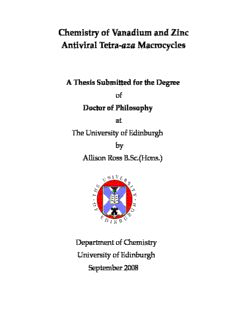
Chemistry of Vanadium and Zinc Antiviral Tetra-aza Macrocycles PDF
Preview Chemistry of Vanadium and Zinc Antiviral Tetra-aza Macrocycles
Chemistry of Vanadium and Zinc Antiviral Tetra-aza Macrocycles A Thesis Submitted for the Degree of Doctor of Philosophy at The University of Edinburgh by Allison Ross B.Sc.(Hons.) Department of Chemistry University of Edinburgh September 2008 DECLARATION..............................................................................I ACKNOWLEDGEMENTS...........................................................II ABSTRACT....................................................................................IV ABBREVIATIONS......................................................................VII APPENDICES................................................................................XI 1. INTRODUCTION.................................................................... 1 1.1. Bioactivity of macrocycles........................................................................ 1 1.1.1. Synthetic Macrocycles.................................................................... 3 1.2. HIV and AIDS............................................................................................ 7 1.2.1. Polyoxometallates........................................................................... 8 1.3. Existing drug treatments........................................................................ 10 1.3.1. Reverse transcriptase inhibitors (RTIs)....................................... 10 1.3.2. Protease inhibitors (pharmacology)............................................. 13 1.3.3. Entry inhibitors............................................................................... 15 1.3.3.1. Fuzeon.............................................................................................. 15 1.3.3.2. Maraviroc..........................................................................................16 1.3.3.3. AMD3100..........................................................................................18 1.3.3.4. Metal Complexes............................................................................. 19 1.4. Cyclam and bicyclam................................................................................ 23 1.4.1. Configurational isomers and transition metal complexes........ 25 1.4.2. Constrained cyclam complexes.................................................. 27 1.4.3. Proposed mechanism of antiviral activity................................... 29 1.4.4. Metalloporphyrins.......................................................................... 30 1.5. Vanadium as a bioactive metal................................................................31 1.5.1. Vanadium......................................................................................... 31 1.5.2. Vanadium in macrocycles.............................................................. 34 1.6. Aims of thesis............................................................................................. 35 1.7. Bibliography............................................................................................... 37 2. MATERIALS AND METHODS............................................ 41 2.1. Chemicals and instruments......................................................................41 2.1.1. Chemicals......................................................................................... 41 2.1.2. I R spectroscopy.............................................................................. 41 2.1.3. Conductivity measurements......................................................... 41 2.1.4. Resonance Raman spectroscopy................................................... 42 2.1.5. NMR spectroscopy.......................................................................... 42 2.1.6. X-ray crystallography..................................................................... 43 2.1.7. CHN analysis.................................................................................. 43 2.1.8. Electrospray ionisation-mass spectrometry (ESI-MS)............... 43 2.1.9. Ultraviolet and visible spectroscopy (UV-Vis)........................... 43 2.1.10. pH measurements........................................................................... 44 2.1.11. EPR spectroscopy............................................................................ 44 2.1.12. X-ray absorption near edge structure (XANES) and Extended X-ray absorption fine structure (EXAFS)................ 44 2.1.12.1. V K Edge XANES/EXAFS............................................................. 44 2.2. IR spectroscopy........................................................................................... 45 2.3. Resonance Raman spectroscopy.............................................................. 47 2.4. NMR spectroscopy..................................................................................... 48 2.4.1. Nuclear spin and chemical shift................................................... 49 2.4.2. Spin-spin coupling and quadrupolar relaxation........................ 51 2.4.3. Paramagnetic effects in NMR spectra.......................................... 52 2.4.4. 2D NMR spectroscopy................................................................... 52 2.4.4.1. COrrelation SpectroscopY (COSY) and TOtal Correlation SpectroscopY (TOCSY)................................................................... 53 2.4.4.2. Heteronuclear Single-Quantum Correlation (HSQC)............... 54 15 2.4.4.3. N NMR spectroscopy................................................................... 55 2.5. EPR spectroscopy....................................................................................... 55 2.5.1. Spin-lattice relaxation..................................................................... 56 2.5.2. Hyperfine splitting.......................................................................... 56 2.5.3. Line widths and intensities............................................................ 57 2.5.4. Magnetic moment and g-factor..................................................... 57 4+ 2+ 2.5.5. EPR of V and VO ....................................................................... 60 2.6. Bibliography............................................................................................... 62 3. OXOVANADIUM(IV) CYCLAM COMPLEXES.....................63 3.1. Experimental.....................................................................................................64 3.2. Materials............................................................................................................65 3.3. Results................................................................................................................65 3.3.1. Magnetic measurements.......................................................................65 3.3.2. X-ray crystallography............................................................................67 3.3.3. FTIR and resonance Raman spectroscopy..........................................78 3.3.4. Conductivity measurements.................................................................83 3.3.5. EPR spectroscopy...................................................................................84 3.3.6. EXAFS/XANES.......................................................................................87 3.3.7. Antiviral HIV Tests................................................................................89 3.3.8. In-silico docking with bovine rhodopsin template...........................93 3.4. Discussion.........................................................................................................97 3.4.1. Oxovanadium(IV) cyclam complexes in the solid state...................97 3.4.1.1. Magnetic measurements.......................................................................97 3.4.1.2. X-ray crystallography............................................................................97 3.4.1.3. Infrared and resonance Raman spectroscopy...................................99 3.4.1.4. EXAFS....................................................................................................100 3.4.2. Oxovanadium(IV) cyclam complexes in solution...........................101 3.4.2.1. Infrared spectroscopy..........................................................................101 3.4.2.2. Conductivity measurements..............................................................102 3.4.2.3. EPR spectroscopy.................................................................................103 3.4.3. Oxovanadium(IV) cyclam complexes in-silico................................104 3.5. Conclusion........................................................................................................107 3.6. Bibliography.....................................................................................................109 4. OXOVANADIUM(IV) BICYCLAM COMPLEXES.................111 4.1. Experimental.....................................................................................................112 4.1.1. Materials................................................................................................112 4.1.2. Synthesis of Xylyl-bicyclam, 16..........................................................113 4.1.3. Syntheses of oxovanadium(IV) cyclam complexes with aromatic pendant arm substituents...................................................................114 4.1.3.1. Synthesis of oxovanadium(IV) bicyclam complexes......................114 4.1.3.2. Synthesis of oxovanadium(IV) naphthyl complexes......................116 4.1.4. FTIR and resonance Raman spectroscopy.......................................117 4.1.5. UV-Vis spectroscopy...........................................................................120 4.1.6. EPR spectroscopy.................................................................................121 4.1.7. EXAFS/XANES.....................................................................................126 4.1.8. Anti-HIV activity..................................................................................130 4.2. Discussion.........................................................................................................132 4.3. Conclusion........................................................................................................137 4.4. Bibliography.....................................................................................................139 5. ZINC(II) CONSTRAINED CYCLAMS.....................................140 5.1. Experimental.....................................................................................................143 5.1.1. Materials..............................................................................................144 5.2. Results................................................................................................................144 5.2.1. Infrared spectroscopy........................................................................144 5.2.2. X-ray crystallography.......................................................................145 5.2.3. Comparison of bond lengths and angles.......................................154 5.2.3.1. Zinc-oxygen bonds, (Zn(II)-HMC, 36)............................................154 5.2.3.2. Zinc-nitrogen bonds, (Zn(II)-HMC, 36)..........................................154 5.2.3.3. Zinc-chloride bonds, (Zn(II)-NHMC, 41).......................................156 5.2.3.4. Zinc-nitrogen bonds, (Zn(II)-NHMC, 41).......................................156 5.2.4. NMR spectroscopy.............................................................................158 5.3. Antiviral testing...............................................................................................165 5.3.1. Anti-HIV.............................................................................................165 5.3.2. Antibody binding competition tests...............................................167 5.4. Discussion.........................................................................................................168 5.4.1. Infrared spectroscopy......................................................................168 5.4.2. NMR spectroscopy of Zn(II)-hexyl-Me -cyclams........................171 2 5.5. Conclusion........................................................................................................172 5.6. Bibliography.....................................................................................................174 6. CONCLUSIONS AND FUTURE WORK..................................176 6.1. Conclusions......................................................................................................176 6.2. Future work......................................................................................................178 6.2.1. Oxovanadium(IV) complexes......................................................178 6.2.2. Zinc(II) constrained cyclam complexes......................................181 6.3. Conferences attended.....................................................................................182 6.4. Bibliography.....................................................................................................184 7. EXPERIMENTAL...........................................................................185 7.1. General experimental......................................................................................185 7.1.1. Materials........................................................................................185 7.1.2. Infrared spectroscopy .................................................................185 7.1.3. Thin layer chromatography........................................................185 7.1.4. Flash column chromatography..................................................186 7.1.5. Mass spectrometry.......................................................................186 7.1.6. Nuclear magnetic resonance spectroscopy..............................186 7.1.7. Evaporation of solvents...............................................................186 7.1.8. Nomenclature...............................................................................187 7.1.9. Crystallographic data .................................................................187 7.1.10. Glassware......................................................................................187 7.2. Synthesis of oxovanadium(IV) and zinc(II) complexes...........................188 7.3. Antibody competition binding tests...........................................................202 7.3.1. Cell cultures.................................................................................202 7.3.2. Antibodies, chemokines and fluorescent dyes......................203 7.3.3. Assay to measure displacement of antagonist......................203 7.4. Bibliography....................................................................................................204 Declaration I hereby declare that except where specific reference is made to other sources, the work contained in this thesis is the original work of the author. It has been composed by myself and has not been submitted, in whole or in part of, for any other degree, diploma or other qualification. Allison Ross September 2008 i Acknowledgements I would like to thank my supervisor, Professor Peter J Sadler, FRS, for his support, advice and encouragement throughout the project and for always being available when needed. It has been a most enjoyable three years and I am privileged to have worked for him. My sincere thanks go to the Sadler research group for members past and present, both in Edinburgh and Warwick, for their continued support and friendship. In particular, special thanks are due to Dr Ana Pizarro and Dr Abraha Habtemariam for invaluable assistance and discussions on many occasions. I would also like to thank Dr Neil Robertson for acting as my second supervisor in Edinburgh when Professor Sadler moved to Warwick University. Thanks are also due to Professor Simon Parsons and his research group, and the EPSRC National Crystallographic Service at the University of Southampton for the crystallography work in this thesis. I also thank Mr Juraj Bella for assistance with NMR experiments. I am very grateful to Dr Daniel Stone, National EPR Service, University of Manchester for all his help with EPR data simulations and Miss Danielle Covelli, University of British Columbia, for her assistance with the EXAFS/XANES data. A very special thank you is due to Dr Peter J Kirsop of the University of Edinburgh for many invaluable discussions, and for his support, patience and understanding throughout the project. ii
Description: